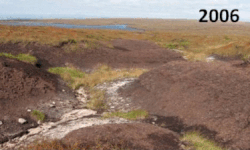Sustainable Catchment Monitoring Programme (SCaMP)
 United Utilities’ Sustainable Catchment Management Programme (SCaMP) aims to improve catchment quality for nature conservation, raw drinking water and carbon retention via implementation of a suite of habitat restoration measures.
United Utilities’ Sustainable Catchment Management Programme (SCaMP) aims to improve catchment quality for nature conservation, raw drinking water and carbon retention via implementation of a suite of habitat restoration measures.
Monitored over a 10-year period, and set to continue to 2020, the results form a significant dataset for the analysis and interpretation of the impacts of restoration on peat groundwater levels, colour production/release and vegetation enhancement. Data from the SCaMP catchments in North-West England show positive trends across the majority of the factors measured.
Prior to restoration a number of issues were present across the sites: areas of extensive bare peat; significant artificial drainage and gully erosion; poor vegetation condition and loss of peat from the moorland; and the effects of grazing and burning regimes over decades.
The following restoration measures were applied across 12,300ha of blanket bog:
• 85km grips blocked with peat or plastic dams.
• 470ha eroding bare peat treated with ‘nurse’ crop, heather brash, geojute textile.
• ‘Novel’ coir roll installation.
• Gully blocking with stone dams.
• Reduced or removed grazing and burning across all sites.
 The monitoring programme developed by PAA covered three main interest areas: hydrology – peat water levels, stage discharge, rainfall gauges; water colour (DOC) and turbidity (POC); and vegetation quadrats within plots, including reference plots and fixed point photography.
The monitoring programme developed by PAA covered three main interest areas: hydrology – peat water levels, stage discharge, rainfall gauges; water colour (DOC) and turbidity (POC); and vegetation quadrats within plots, including reference plots and fixed point photography.
Results
• Significant reductions in bare peat and increases in vegetation cover were identified.
• Sphagnum cover is increasing where present, responding more quickly if greater cover remains.
• Removing/reducing grazing and burning alone results in positive change, in some areas.
• Stabilising bare peat is important in re-vegetation of bare peat.
• Nurse crop treatment is effective in promoting revegetation.
• Additional heather brash and geojute encourages more rapid re-vegetation of slopes, geojute is important on steeper slopes.
• Water quality is improving with reductions in colour (and turbidity), although colour is still problematic on severely eroded catchments.
• Peat water levels are generally increasing and stabilising, except where severe degradation has occurred.

United Utilities have commissioned PAA to prepare two peer-reviewed research papers, based
on the results and observations gained from over nine years of SCaMP monitoring. Research ‘themes’ identified for publication include:
• An overview paper, presenting the key themes and outcomes from the SCaMP Project.
• Comparing the SCaMP water quality monitoring results within the context of general trends and trajectories in environmental monitoring data, collected nationally.
• A conceptual model of dissolved organic carbon (raw water colour) and a Bayesian
Network Belief Model to demonstrate the complex interactions between key drivers
of DOC production and release.
For more details on the SCaMP project please contact us, or feel free to browse the SCaMP publications catalogue. Follow the links below for more information on our range of related services:





